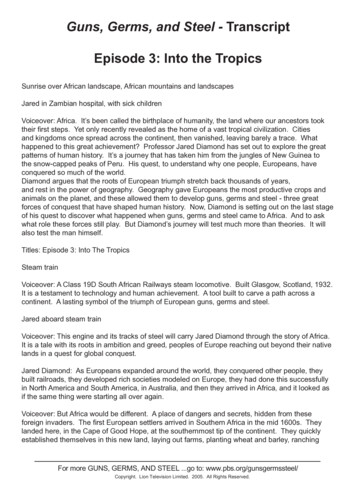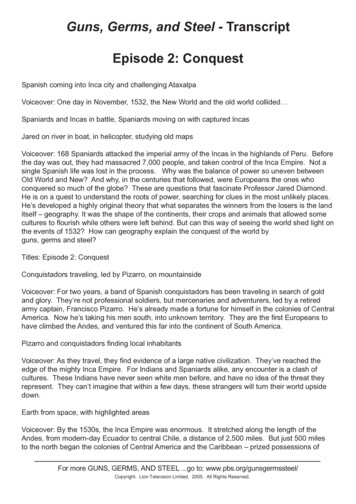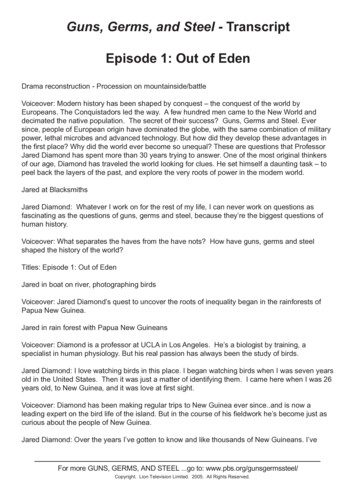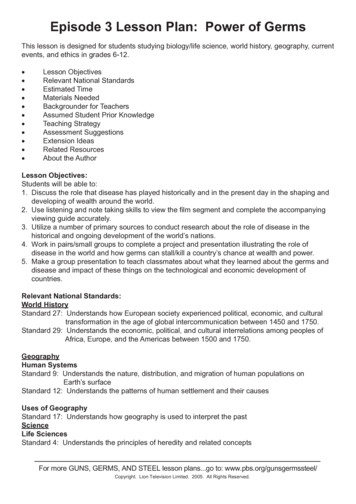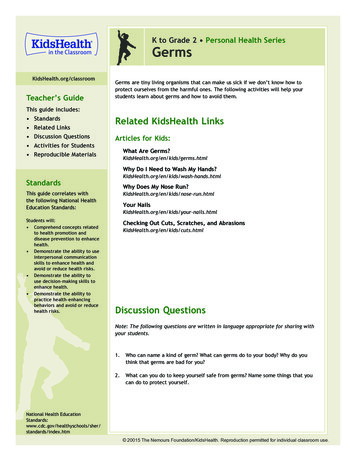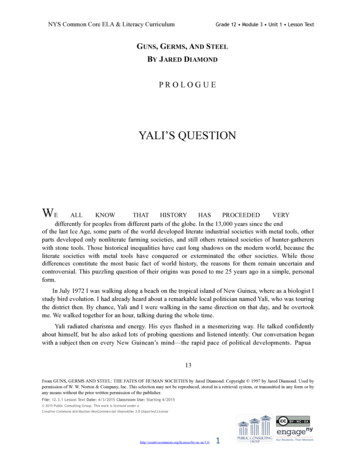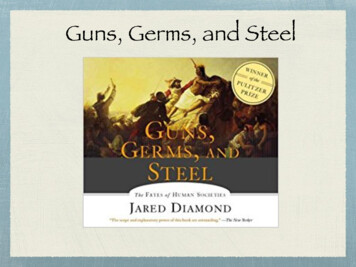
Transcription
Guns, Germs, and Steel
Guns, Germs, and SteelChapter 6 “To Farm or not to Farm”
Guns, Germs, and SteelWhy did humans develop agriculture around 8500 B.C.and not before?
Guns, Germs, and Steel- Agriculture didn’t “spring up” fully formed
Guns, Germs, and SteelHumans slowly developed agriculture through trial and error
Guns, Germs, and SteelHumans slowly developed agriculture through trial and errorHow do you say “trial and error” in Japanese?
Guns, Germs, and SteelHumans slowly developed agriculture through trial and errorHow do you say “trial and error” in Japanese?
Guns, Germs, and SteelSome people were both hunter-gatherers and agriculturalists
Guns, Germs, and SteelSome people were both hunter-gatherers and agriculturalistsHunter-gatherers sometimes adopted agriculture for awhile and then returned to their old practices
Guns, Germs, and SteelIt was a long time after 8500 B.C. before any society’s foodsources were entirely agricultural
Guns, Germs, and SteelIt was a long time after 8500 B.C. before any society’s foodsources were entirely agriculturalIn the last 10,000 years, it’s become increasingly difficultto be a hunter-gatherer
Guns, Germs, and SteelWild foods have become less available
Guns, Germs, and SteelWild foods have become less availableMost of the world’s large mammal species have gone extinct
Guns, Germs, and SteelWild foods have become less availableMost of the world’s large mammal species have gone extinctAlso
Guns, Germs, and SteelAgriculture can support larger populations
Guns, Germs, and SteelAgriculture can support larger populationshumans were motivated to experiment with agriculturebecause it promised to feed them enough to survive
Agriculture depended upon the existence oftechnologies
Agriculture depended upon the existence oftechnologies(like the hoe ( )
Agriculture depended upon the existence oftechnologies(like the hoe (鍬)
Agriculture depended upon the existence oftechnologies(like the hoe (鍬)and the awl ( )
Agriculture depended upon the existence oftechnologies(like the hoe (鍬)and the awl (突き錐)
These technologies didn't exist before about 10,000years ago
These technologies didn't exist before about 10,000years agoGradually, environmental changes and the rise ofhuman technology and population densitymotivated people to pursue agriculture
These technologies didn't exist before about 10,000years agoGradually, environmental changes and the rise ofhuman technology and population densitymotivated people to pursue agriculture
These technologies didn't exist before about 10,000years agoGradually, environmental changes and the rise ofhuman technology and population densitymotivated people to pursue agriculture
These technologies didn't exist before about 10,000years agoGradually, environmental changes and the rise ofhuman technology and population densitymotivated people to pursue agriculture
The decision to pursue agriculture instead of hunter-gathererpractices was motivated by practicality more than anything else
The decision to pursue agriculture instead of hunter-gathererpractices was motivated by practicality more than anything else
Humans realized that their best chance of feeding themselvesinvolved growing crops, not killing large (wild) mammals
Hunting-Gathering
Hunting-Gathering
Hunting-Gathering
Hunting-Gathering
AgricultureAFor the most part, there is aconstant food supply.Less time is spent ongathering more food, somore time can be used fornew thingsMore food is grown, so therecan be a higher population.
AgricultureAFor the most part, there is aconstant food supply.Less time is spent ongathering more food, somore time can be used fornew thingsMore food is grown, so therecan be a higher population.
Agriculture
Agriculture
Guns, Germs, and SteelChapter 7 “How to Make an Almond”
One of the most important aspects of agriculture is thedomestication of crops
One of the most important aspects of agriculture is thedomestication of crops
One of the most important aspects of agriculture is thedomestication of cropsdomesticated
By the way, how do you say “domesticate”in Japanese?domesticated
By the way, how do you say “domesticate”in �すこと、順応domesticated
Who came up with the idea to domesticate a crop?
Who came up with the idea to domesticate a crop?Many animals select the kinds of plants they want to eatunintentionally by:
Who came up with the idea to domesticate a crop?Many animals select the kinds of plants they want to eatunintentionally by:Eating them —-
Who came up with the idea to domesticate a crop?Many animals select the kinds of plants they want to eatunintentionally by:spreading them to other places (by walking or flying) —
Who came up with the idea to domesticate a crop?Many animals select the kinds of plants they want to eatunintentionally by:Planting them in the earth again (by defecating) —-
Result:
Result:Most plant seeds have evolved to survive beingdigested by most animals
The earliest farmers didn’t fully understand theirdomestication practices
They just understood that if they planted certainseeds, they would get certain kinds of crops
The almond was once dangerous to eat
The almond was once dangerous to eatDomestication made the almond edible and tasty
Humans chose almond crops without poisonous seedsand planted them, until domesticated almonds (nonbitter and non-poisonous) outnumbered wild almonds
This is natural selection
This is natural selectionBirds eat the green beetles
This is natural selectionFewer green beetles
This is natural selectionBrown beetles flourish (繁盛する)
The agricultural revolution began in the FertileCrescent of Mesopotamia
stalk
stalk(茎)くき
Seeds that remain in their stalks (茎) areevolutionarily useless - they just die withoutproducing a new generation of plantsstalk(茎)
However, these “useless” seeds became usefulfor humans
Farmers removed the seeds from their stalks andplanted them in the ground
The result (after many thousands of years)—- —- —-
Domesticated plants have evolved to onlyproduce seeds that remain in the stalk
Humans prefer grains that grew quickly and couldbe harvested easily
Self-fertilization
Self-fertilizationWhat does “Self-fertilization” mean?
Self-fertilizationWhat does “Self-fertilization” mean?自己受精
Self-fertilization is an important way crops havedeveloped over thousands of years
Self-fertilization is an important way crops havedeveloped over thousands of yearsSelf-fertilization was once the minority case
Self-fertilization is an important way crops havedeveloped over thousands of yearsSelf-fertilization was once the minority caseSelf-fertilization has an evolutionary advantageover ordinary plant fertilization
Self-fertilization is an important way crops havedeveloped over thousands of yearsSelf-fertilization was once the minority caseSelf-fertilization has an evolutionary advantageover ordinary plant fertilizationSelf-fertilizing crops eventually outstrippedthe “normal” crops
Ancient farmers didn’t really understand thisconcept; they just planted the crops they liked
Ancient farmers didn’t really understand thisconcept; they just planted the crops they likedThe original domesticated crops were
Ancient farmers didn’t really understand thisconcept; they just planted the crops they likedThe original domesticated crops were
Ancient farmers didn’t really understand thisconcept; they just planted the crops they likedThe original domesticated crops were wheat and barley
Wheat and Barley
Wheat and Barleyprobably because they were
Wheat and Barleyprobably because they were fast-growing
Wheat and Barleyprobably because they were fast-growingeasy to harvest
Wheat and Barleyprobably because they were fast-growingself-pollinatingeasy to harvest
Wheat and Barleyprobably because they were fast-growingeasy to harvestself-pollinatingWhat does “self-pollinating” mean?
Wheat and Barleyprobably because they were fast-growingeasy to harvestself-pollinatingWhat does “self-pollinating” mean?
Wheat and Barleyprobably because they were fast-growingeasy to harvestself-pollinatingWhat does “self-pollinating” mean?自家受粉
Humans learned to domesticate different plantsat different times
Humans learned to domesticate different plantsat different timesHumans learned to domesticate fast-growing,easy-to-harvest crops first
Humans learned to domesticate different plantsat different timesHumans learned to domesticate fast-growing,easy-to-harvest crops firstSlow-growing crops later on (if at all)
Ancient Romans (2000 years ago)
Ancient Romans (2000 years ago)Most of the world’s leading crops (wheat, corn, rice )were being grown somewhere in the world
Ancient Romans (2000 years ago)Most of the world’s leading crops (wheat, corn, rice )were being grown somewhere in the worldCertain qualities make plants easy or hard to domesticate
Acorns have never been domesticated because
they’re slow-growing
they’re slow-growingsquirrels eat many acorns
they’re slow-growingsquirrels eat many acornsIt’s hard to “breed out” (genetically complex)bitterness in an acorn
they’re slow-growingsquirrels eat many acornsIt’s hard to “breed out” (genetically complex)bitterness in an acorn苦味を “繁殖"させることは大変
This shows the thoroughness of ancientagriculture
This shows the thoroughness of ancientagricultureAncient farmers domesticated pretty mucheverything that could be domesticated
This shows the thoroughness of ancientagricultureAncient farmers domesticated pretty mucheverything that could be domesticatedDomestication of crops is evolution in action
Domestication of crops is evolution in action
Agriculturalists prefer crops with certaincharacteristics (taste, ease of harvest, etc.)
Agriculturalists prefer crops with certaincharacteristics (taste, ease of harvest, etc.)
Agriculturalists prefer crops with certaincharacteristics (taste, ease of harvest, etc.)Rice
Agriculturalists prefer crops with certaincharacteristics (taste, ease of harvest, etc.)Rice
Agriculturalists prefer crops with certaincharacteristics (taste, ease of harvest, etc.)RiceWheat
Agriculturalists prefer crops with certaincharacteristics (taste, ease of harvest, etc.)RiceWheat
Agriculturalists prefer crops with certaincharacteristics (taste, ease of harvest, etc.)RiceCornWheat
Agriculturalists prefer crops with certaincharacteristics (taste, ease of harvest, etc.)Eventually these crops are the “fittest” for theirenvironment and come to outnumber other kinds
Guns, Germs, and Steel Hunter-gatherers sometimes adopted agriculture for a while and then returned to their old practices. It was a long time after 8500 B.C. before any society's food sources were entirely agricultural Guns, Germs, and Steel .
